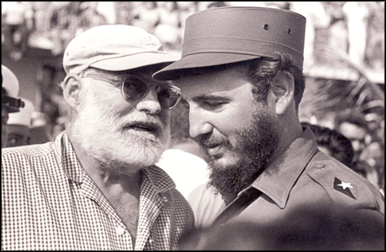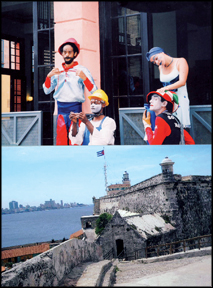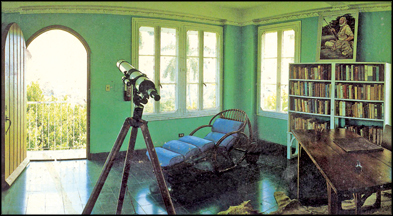Enchanting journey to Havana
 A nostalgic journey to that certain Havana of the fifties' Havana,
one time referred to as The Sexiest City in the World. The land of
Cohibas and Chicas passionately blended with balmy breezes, the
smoothest rum and the rhythms of the rumba beat. A nostalgic journey to that certain Havana of the fifties' Havana,
one time referred to as The Sexiest City in the World. The land of
Cohibas and Chicas passionately blended with balmy breezes, the
smoothest rum and the rhythms of the rumba beat.
I was always drawn to the fantasy of a slightly dangerous but sensual
Havana, a place of intrigue and romance after having heard of this
popular international playground of the rich, the famous and the
infamous, from my father, who was an importer of Cuban sugar from the
famous Galban Lobo Sugar Company in the fifties.
The fields of sugar cane, the aroma of cigars, the vibrating tempo of
the salsa, the clear blue sea, a city occupied and influential by a
variety of nations in a country of a diverse and complex culture. A
colourful, enchanting Island paradise inhabited by an enticing, friendly
large hearted people, despite the severe economic difficulties, but
holding on to a subtle innocence and a unique identity.
|

Ernest Hemingway and Fidel Castro |
My school-mate Michael Modder from Brighton, England and I have been
aficionados of 'that certain Havana of the fifties'. Rumbling to the
Latin beat, the flashy American cars and movies depicting or made in
Cuba in the 50s.
The Mafioso extravagance that made dazzling Havana, a kingdom of
tolerance where anything could be arranged with the greatest of impunity
and the hedonistic lifestyle of that time. Mike and I, like many others,
are ardent fans of Somerset Maugham, Graham Greene and most of all of
"Papa" Ernest Hemingway.
This then, is a nostalgic tourney to "that certain Havana of the
fifties", sometimes swaying, intoxicated by one-too-many mojitos and the
strumming of a trees, in search of our youthful fantasy of that exciting
era. The exquisite architectural sophistication and garish art-deco, the
Collectors Models of Detroit designed pleasure on wheels and the life
and styles of the giant sized personalities of that romantic, reckless
and exciting decade.
We don't cover it all, but we hope that we have touched the sometimes
elusive essence of those heady times. A little taste of the most exotic
and controversial Island basking in the Caribbean sun.
Kissed by the Atlantic Ocean, the Caribbean sea and the waters of the
Gulf of Mexico Cuba is the largest Island in the Greater Antilles
situated just South of the Tropic of Cancer. It lies only 112 miles from
Florida and 130 miles from Mexico and 50 miles from Haiti and 87 miles
from Jamaica.
Havana is the city that made Hemingway want, "to stay forever".
Havana is inhabited by a cultured and sensual people who could very well
be characters out of the novels by Graham Greene and Ernest Hemingway.
Their human values, their kindness, hospitality, helpfulness is
unequalled.
The exquisite old buildings are still holding their own, still rich
in historical character and have not been overtaken by shiny modern
structures, shopping malls and fast food outlets. Now is a fascinating
and exceptional moment in the history of Cuba, as it emerges from the
50s time warp. Slowly but surely, still preserving its fragile magic
that may very well disappear.
In 1950s, Havana was North America's premier playground, with
beautiful lissome dancers imported from various parts of the world and
dark haired senoritas swaying to the musical rhythms of the Caribbean.
One of the great historical cities of the New World - Havana (pop.
2.2 million) It has a flavour of its own. a combination - surreal and
sensual of colonization, capitalism and communism. Neapolitan streets,
Spanish colonial buildings. A spectacular blend of styles, new classical
and baroque modern art-deco and art nouveau.
At the heart of the city's enchanting Habana Veija (old Havana), 4.5
square Km of a living museum that contains the finest collection of
Spanish colonial buildings in all the America's Churches. Convents and
Castles. Shaded city streets with walls of faded tropical pastels. It
consists of two major plazas of great significance.
Ernest Hemingway in Cuba
|

Above:Cuban Art forms
Below: Entrance to Havana
from the sea |
The great American author fell in love with Cuba on his first visit
in 1932, attracted initially by the martin fishing. It was not until
1939. However, that Hemingway decided to move to the Island, initially
settling down in the Ambos Mundos hotel in Old Havana.
Having decided to stay on, he found a quiet villa outside the town in
which to write. Finca La Vigia, where he lived at first with journalist
Martha Gellhorn, whom he married in 1940.
His bond with Cuba lasted 20 years, through the Batista period and
the beginning of the Revolution, and longer, in fact, than his
relationship with Martha Gellhorn.
Hemingway's last wife, Mary Welsh whom he married in 1946 joined the
writer in Cuba and lived with him at Finca La Vigia. The villa is now a
museum. He eventually returned to the US in 1960, a year before his
suicide.
The year 1928 became very complicated. Settled in Key West, Hemingway
began to write in the back of a tavern.
Then in June he moved with his wife to Kansas City as they prepared
for the birth of Ernest's second son, Patrick.
Towards the end of the same year, on December, his father committed
suicide in Oak Park.
Also in 1928 Hemingway came into contact with people who would
influence his future. Caught up in the complex process of finishing and
revising "A Farewell to Arms", whenever something confounded him, he
took up some other activity, in the evening or at night, or he stopped
working for two or three days. and Key West was no exception.
In those days, Hemingway began to visit routinely a place filled with
adventure, the virtually unknown Sloppy Joes of Key West.
Of all the people he met in Key West, the one who made the greatest
impression was Joe Russell, the owner of Sloppy Joe's. He was a man who
lived on the edge. Joe made repeated trips to Havana to acquire rum and
other alcohol for the consumption of the restless clientele who
frequented his establishment, thumbing their noses at Prohibition.
That same year, Hemingway began his first journey in the Gulf Stream,
in the company of Joe Russell. He also became acquainted with Eddy Bra
Sanders, who told him how he had plundered the steamer Varbanera. In the
midst of a cyclone this ship had not been able to reach the port of
Havana and had to face the storm at sea, which resulted in its being
stranded on the sands of the Bahamas. Based on that tale
Hemingway later wrote the story "After the Storm". By the end of
1929, Hemmgway's place in the literary panorama of his country had been
solidified, from journalism to masterpieces. It was a heroic time, with
three novels published. He had also published a few poems and a number
of short stories.
|

Hemingway’s study |
In April 1929 Hemingway returned to Havana, this time with Joe
Russell on his yacht Anita. It could sail strong currents and difficult
seas. It is said that Hemingway rented it for twenty dollars a day,
which seems improbable if we consider that Joe always accompanied him.
They planned to spend several days deep-sea fishing in the Gulf Stream.
But for very special reasons, that stay in the Cuban capital was
prolonged for more than two months.
They occupied their mornings with fishing trips, and in the evenings
they would go to the horse races, when the writer was not revising the
gallery proofs of "Death in the Afternoon". The night was for eating and
drinking and for visits to the jai alai court. There were parties and
strolls through famous streets and quarters of Havana, and some
womanizing.
Papa and Jane
Hemingway paid two dollars a day for a room (the room that would
become his favourite, his permanent room) in the Ambos Mundos Hotel on
Obispo Street.
Furthermore, everything indicates that it was during this second stay
in Havana that Hemingway met one of the most beautiful and unpredictable
women of the time, the charming Jane Mason, when she was barely twenty
years old.
Beginning in 1929, Hemingway was constantly on the Cuban coast, as
his fascination for the Cuban capital grew, and he could not resist the
temptation to enter the port of Havana time and again.The ultimate
purpose of those trips was to see the radiant Jane Mason. As a result,
the writer saw his ties to Havana become ever more complicated, knowing
full well that he had written one of the most important novels of the
period.
The Masons, Jane and Grant, owned a beautiful mansion on the banks of
the Jaimanitas River. It was a beach house atop a sloping, sandy bank,
cared for by a dozen servants, a house with big doors from which one
could see the whole cove, including bars and lodgings and a small pier
right at the mouth of the Jaimanitas River. The Masons house was
surrounded by a garden that resembled a small jungle, with grapevines.
Coconut trees and flowers. It had a swimming pool that extended almost
to the seashore, surrounded by a tow fence.
>From then on Hemingway began to cross the Gulf Stream repeatedly and
it was not exactly to go fishing, or to contemplate the splendours of
Havana. His destination was something else, as he himself wrote in one
of his famous chronicles without ever giving any fuller explanation
about his nights spent in the Sans Souci Cabaret and the dawns in
Jaimanitas.
The writer used to anchor his boat in the cove of the Jaimanitas
River, the source of various rumours and legends related to the
smuggling of rum and of other sea stories that are lost in time.
In the company of Jane Mason, Hemingway developed an almost excessive
liking for the splendours of Havana. Jane loved strong drink, and she
drove her car wildly She piloted her boat masterfully, and she fished
and hunted like the most experienced adventurer and she even made a trip
to Africa to practise hunting, to say nothing of the fame she achieved
among hunters in Havana.Those familiar with her life in the Cuban
capital assure that Jane had a classic, wild somewhat delicate air, with
beautiful big blue eyes, a lovely complexion, and an admirable figure.
She was surprising, elegant, with abundant strawberry-red hair that she
parted in the middle. On occasion it fell carelessly over her forehead,
especially when she relaxed, which seldom happened, because according to
everybody, Jane was the most unpredictable woman of her age.Jeffrey
Meyers affirms that Jane Mason was as beautiful as Grace Kelly, more
sensual than Duff Twysden, and as turbulent, extravagant, and as
outrageous as Zelda Fitzgerald, the wife of the writer F. Scott
Fitzgerald, a couple whom Hemingway had known in Paris during the 1920s.
Jane's husband, Grant Mason, known as a successful man, was head of
several businesses and had become very rich in Cuba. In Havana Mason's
businesses were so profitable that he rapidly became a multimillionaire
before he left Cuba definitively in 1939 but early in the 1930s. Grant
began to extend his businesses throughout the area, for which reason he
was often absent from the Cuban capital. He travelled frequently to
Venezuela Panama, the Dominican Republic and Haiti. Mexico, Central
America, and the United States. He was constantly travelling while Jane
remained on the banks of the Jaimanitas.
Nothing stopped them. Until 1936 there was an intense and scandalous
love affair between the writer Ernest Hemingway and the voluptuous Jane
Mason.
The citizens of Havana used to see them everywhere, in the most
unusual places. It was common to see them in the taverns near the port,
going from one spot to another, or on to a boat, or making the rounds of
the casinos and cabarets; and in the evening they would meet in an
exquisite restaurant, when they were not staying in the aristocratic
Hotel Nacional of Cuba, overlooking Havana's seaside drive, from which
they could contemplate the intense blue of the sea. For Hemmgway, this
was the beginning of ten years of trips and stays in Havana before he
would establish himself definitively in Havana, surrounded by a charming
landscape, which would include a view of the nearby low hills on the
other side of the bay, where the old fishermen's quarters were.
It was in these places, in those early years with lovely Jane Mason,
that the myth began to take root among Cubans, as though little by
little Hemingway was taking possession of plazas, piers, streets and
bars, canteens and restaurants, hotels and other spots along the coast
near the Cuban capital.
The Land of Miracles
Everything served to make Hemingway have an even greater liking for
Havana.
The city he glimpsed during a brief lay over, the city to which he
would return from Key West, exploring its streets and taverns,
observing, listening, inebriated at times, on nights of drinking,
womanizing in the most splendid places, and acquiring habits that would
lead him hopelessly to seek refuge on the fifth floor of a peaceful and
protective little hotel on Obispo Street, in a Havana dominated by
uncertainty and abandon. A Havana scourged by a cruel tyranny, ruled by
General Machado, whose delusions of grandeur immersed the country in
enormous projects that allowed greedy groups of lawbreakers to establish
themselves in Cuba.
In Havana Hemingway comes into contact with adventurers, sailors,
fishermen, millionaires, famous people from Hollywood, politicians,
boxers, photographers, baseball players, jai alai players, jockeys,
street vendors, taxi drivers, clerks, prostitutes, policemen and
Mafiosos while he cultivated his persona at the centre of one of the
most fascinating myths that any writer has ever created.It is as though
Hemingway still roamed the streets of Havana, with his corpulence, his
broad shoulders, going to places by the sea, his big feet always bare.
Today it is as though he still wandered through the city with his old
moccasins, without socks, with his rebellious, almost defiant, attitude;
and the tight grey canvas pants and the old blue gingham shirt, and the
sun visor, and the shorts, and the worn out multi-coloured shirt, and
his reputation among hunters as a great marksman.
The first thing that Hemingway did in Cuba was take over the streets
of Old Havana, the area around the Plaza of San Francisco, with its
fountain, and the cafes and piers near the port, cluttered with cote of
Catatonian rope; and the little hotel known as the Ambos Mundos.
He stayed there time and again, and he would return so often to the
room on the fifth floor, with its three windows open to the Northeast
breeze, that the room soon became his.
The novelist also succumbed to the charm of Obispo Street Those nine
blocks always full of people; a narrow noisy street with shops,
canteens, offices, florists and pharmacies, and celebrated cafes and
bars.
Besides Obispo Street, Hemingway enjoyed the informal elegance of the
Florida. His presence in that restaurant, among friends and people from
all corners of the world, characterized an age. It was common to see him
there with Jane Mason.
Hemingway also frequented the town of Casablanca on the other side of
the bay, the International Club, the beaches of Tarana, the little port
of Cojimar, and the succulent meals that were served at La Terraza; and
he wound up involving himself in the mysteries of Chinatown, along Zanja
Street, and enjoying the delicacies served by the waiters at the El
Pacifico restaurant.
The myth
Nevertheless, the most impressive thing is that the myth of Hemingway
in Havana in its early stages, was not created in the realm of
literature, but rather through Hemingway's involvement in everyday
things, in his relations with human beings, in the most universal city
of the Antilles; and this myth has achieved such magnitude, such force
that anybody who roams through the streets of Havana today, if he is
white, tall, strong broad shouldered, if he has a beard and wears a sun
visor, may be surprised by being mistaken for Hemingway, although he had
died many years ago.
The myth was created also among the most experienced fishermen in the
coastal villages and among adventurers who frequented the cafes and
taverns.
The myth was also strong among heavy drinkers, old and young, who
still go to the bars by the port.The myth is present in all quarters of
the city. Hemingway is recalled during reflective moments about fishing,
tides, and drinking. His legend pervades the urban landscape with the
abbreviated towers of the cathedral, and the entrance to the port, and
the colonial fortresses, and above the rooftops, across the bay, the
white buildings on the low hills, with their white buildings, the
schooners, fishing boats, ocean liners and torpedo boats in the bay, the
bars and canteens butt on piles, bars where he used to go to contemplate
the landscape, to have a drink, or simply to talk to some anonymous
sailor.It was Joe Russell who introduced Hemingway to the most enigmatic
sailor of those places, to Carlos Gutierrez, who would serve as skipper
for his friend Ernest Hemingway in those repeated expeditions that he
made to the Cuban coast in the yacht Anita.
Around that time the Ambos Mundos Hotel had become Hemingway's base
for trips along the Northeastern coast of Cuba. By 1933 Hemingway was
familiar with the world of Havana and closely followed Cuban politics.
That same year, he wrote his chronicle "Martin Fishing off the Morro'
based on his deep sea fishing experiences.
To be continued
|

